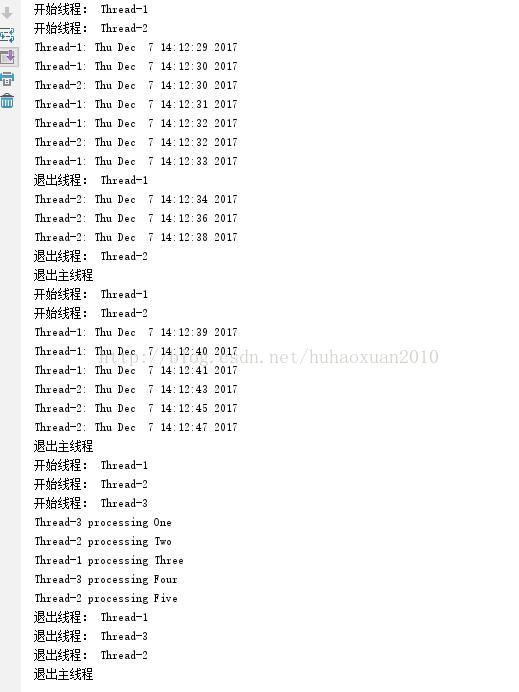Python3.x 多线程
实例如下:
#python多线程
#优点如下:
#1.使用线程可以把占据长时间的程序中的任务放到后台去处理
#2.用户界面可以更加吸引人,这样比如用户点击了一个按钮去触发某些事件的处理,可弹出一个进度条来显示处理进度
#3.程序运行速度可能加快
#4.在一些等待的任务实现上如用户输入、文件读写和网络收发数据等,线程就比较有用了。在这种情况下我们可释放一些资源如内存占用等
#线程分为内核线程和用户线程;内核线程有操作系统内存创建和撤销,用户线程在用户程序中实现;线程可被强占,可睡眠
#Python3中线程常用的两个模块
#1._thread
#2.thrading(推荐使用)
#python使用线程有两种方式:函数或用类来包装线程对象
#函数式:调用_thread模块中的start_new_thread()函数来产生新线程:
#_thread.start_new_thread(function, args[, kwargs])
#function-线程函数
#args-传递给线程函数的参数,必须是tuple类型
#kwargs-可选参数
import _thread
import time
#为线程定义一个函数
def print_time(threadName, delay):
count = 0
while count < 5:
time.sleep(delay)
count += 1
print("%s: %s"%(threadName, time.ctime(time.time())))
#创建两个线程
try:
_thread.start_new_thread(print_time, ("Thread-1", 2,))
_thread.start_new_thread(print_time, ("Thread-2", 4,))
except:
print("Error: 无法启动线程")
while 1:
pass
#使用threading模块创建线程
import threading
import time
exitFlag = 0
class myThread(threading.Thread):
def __init__(self, threadID, name, counter):
threading.Thread.__init__(self)
self.threadID = threadID
self.name = name
self.counter = counter
def run(self):
print("开始线程: " + self.name)
print_time(self.name, self.counter, 5)
print("退出线程: " + self.name)
# 为线程定义一个函数
def print_time(threadName, delay, counter):
while counter:
if exitFlag:
threadName.exit()
time.sleep(delay)
print("%s: %s" % (threadName, time.ctime(time.time())))
counter -= 1
#创建新线程
thread1 = myThread(1, "Thread-1", 1)
thread2 = myThread(2, "Thread-2", 2)
#开启新线程
thread1.start()
thread2.start()
thread1.join()
thread2.join()
print("退出主线程")
#线程同步
#使用Thread对象Lock和Rlock来实现简单的线程同步,这两个对象有acquire方法和release方法,对于那些需要每次只
#允许一个线程操作的数据,可以将其操作放到acquire和release方法之间。
#多线程优势在于可同时运行多个任务,但是当线程需要共享数据时,可能存在数据不同步问题。
import threading
import time
class myThread(threading.Thread):
def __init__(self, threadID, name, counter):
threading.Thread.__init__(self)
self.threadID = threadID
self.name = name
self.counter = counter
def run(self):
print("开始线程: " + self.name)
#获取锁,用于线程同步
threadLock.acquire()
print_time(self.name, self.counter, 3)
#释放锁,开启下一个线程
threadLock.release()
# print("退出线程: " + self.name)
# 为线程定义一个函数
def print_time(threadName, delay, counter):
while counter:
#if exitFlag:
# threadName.exit()
time.sleep(delay)
print("%s: %s" % (threadName, time.ctime(time.time())))
counter -= 1
threadLock = threading.Lock()
threads =[]
#创建新线程
thread1 = myThread(1, "Thread-1", 1)
thread2 = myThread(2, "Thread-2", 2)
#开启新线程
thread1.start()
thread2.start()
#添加线程到线程列表
threads.append(thread1)
threads.append(thread2)
#等待所有线程完成
for t in threads:
t.join()
#thread1.join()
#thread2.join()
print("退出主线程")
#线程优先级队列
#Python的Queue模块中提供了同步的,线程安全的队列类,包括FIFO(先入先出)队列Queue,LIFO(后入先出)队列
#LifoQueue,和优先级队列PriorityQueue
#这些队列实现了锁原语,可在多线程中直接使用,不用额外做线程间同步
import threading
import time
import queue
exitFlag = 0
class myThread(threading.Thread):
def __init__(self, threadID, name, q):
threading.Thread.__init__(self)
self.threadID = threadID
self.name = name
self.q = q
def run(self):
print("开始线程: " + self.name)
#print_time(self.name, self.q)
process_data(self.name, self.q)
print("退出线程: " + self.name)
# 为线程定义一个函数
def process_data(threadName,q):
while not exitFlag:
queueLock.acquire()
if not workQueue.empty():
data = q.get()
queueLock.release()
print("%s processing %s" %(threadName, data))
else:
queueLock.release()
time.sleep(1)
threadList = ["Thread-1", "Thread-2", "Thread-3"]
nameList = ["One", "Two", "Three", "Four", "Five"]
queueLock = threading.Lock()
workQueue = queue.Queue(10)
threads = []
threadID = 1
# print("%s: %s" % (threadName, time.ctime(time.time())))
# counter -= 1
#创建新线程
for tName in threadList:
thread = myThread(threadID, tName, workQueue)
thread.start()
threads.append(thread)
threadID += 1
#填充队列
queueLock.acquire()
for word in nameList:
workQueue.put(word)
queueLock.release()
#等待队列清空
while not workQueue.empty():
pass
#通知线程是时候退出
exitFlag = 1
#等待所有线程完成
for t in threads:
t.join()
print("退出主线程")
#thread1 = myThread(1, "Thread-1", 1)
#thread2 = myThread(2, "Thread-2", 2)
#开启新线程
#thread1.start()
#thread2.start()
#thread1.join()
#thread2.join()
#print("退出主线程")结果:
参考网页

